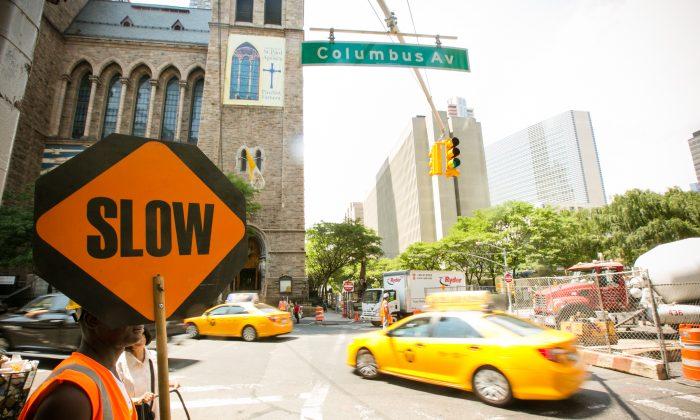Some of the city’s most dangerous streets will be overhauled, with studies to start this year.
Since the city launched its Vision Zero street safety initiative to eliminate traffic fatalities in a decade, pedestrian fatalities are at a record low.
The original Vision Zero came out of Sweden, with a focus on designing around human error. Mayor Bill de Blasio said on Wednesday, as he did last February, that the city would focus on engineering, education, and enforcement to eliminate these deaths.
There were 250 total traffic fatalities in 2014, compared to 293 in 2013.
Redesigns
Much of the success has come from redesigning streets, because that’s what the data called for.
Over half New York City traffic fatalities come from just 15 percent of the streets—the major arteries. On a road that wide, it generally feels natural to speed. A badly designed street can also cause crashes because traffic moves in a conflicting way.
In 2014, the citywide speed limit was lowered from 30 mph to 25 mph. Additional slow zones have been installed, signals have been modified at several intersections to better mitigate vehicle and pedestrian traffic, and physical changes have been made to the widths of some streets.
Queens Boulevard has been nicknamed the “Boulevard of Death.” In 2013, six pedestrians died and over 150 people were injured.
“It is probably the most notorious in the city,” in terms of pedestrian deaths,” de Blasio said at the press conference.
Community visioning sessions to redesign the major roadway will begin in about a month.
“We are going to be taking a very expansive look at what we can do there. Everything is on the table,” Transportation Commissioner Polly Trottenberg said.
2014 Highlights
- 27 new arterial slow zones implemented on more than 120 miles of wide roadways like Atlantic Avenue and the Grand Concourse
- 35 dangerous intersections overhauled; nearly triple the number from 2013
- 400 new speed bumps installed, a 37 percent increase over the previous year
- Redesigns of crash-prone corridors, including stretches of Richmond Avenue on Staten Island, Park Avenue in Manhattan, and Burke Avenue in the Bronx
- 45 leading pedestrian intervals that give pedestrians a head start crossing streets, three times more than in 2013
- Over 5 miles of new protected bike lanes on streets like Lafayette Avenue and Hudson Street in Manhattan, and Brooklyn’s Kent Avenue
Five new neighborhood slow zones lowering speeds on residential streets in Norwood, Clinton Hill, Alphabet City, Brownsville, and Jackson Heights
2015 Priorities
- A dramatic intersection redesign at Hillside Avenue and Metropolitan Avenue in Queens
- A “road diet” on Amsterdam Avenue and protected bike lanes on Fort George Hill in Upper Manhattan
- Improvements on Atlantic Avenue near Washington and Underhill avenues in Brooklyn
- A complex intersection redesign at Jackson and Westchester avenues in the Bronx
50 miles of new bike lanes along routes like Staten Island’s Clove Road, and at least 100 blocks of protected bike lanes as part of that goal
Source of the fact boxes: NYC Office of the Mayor




